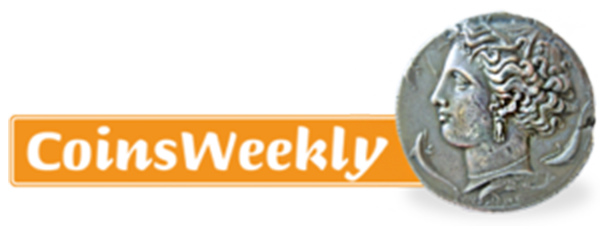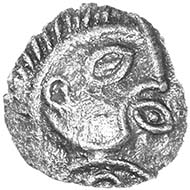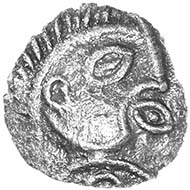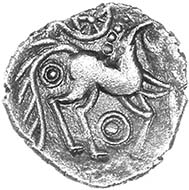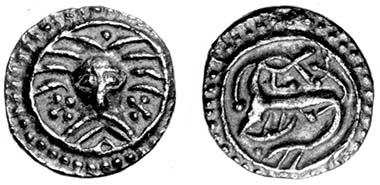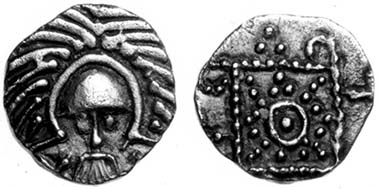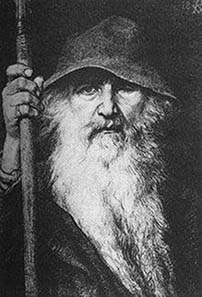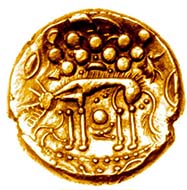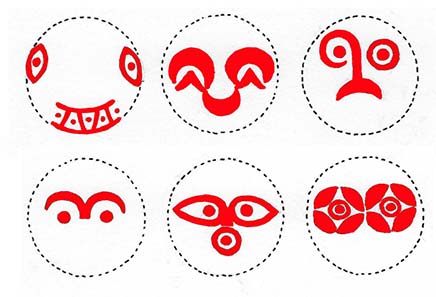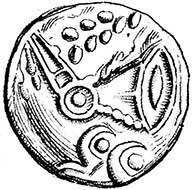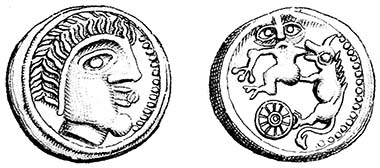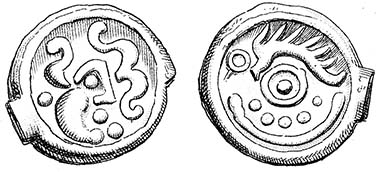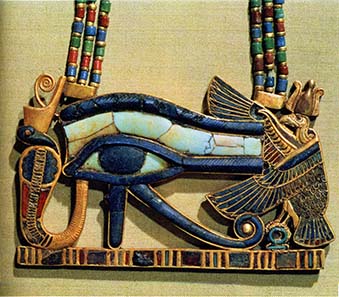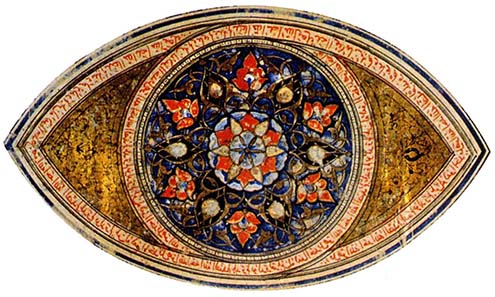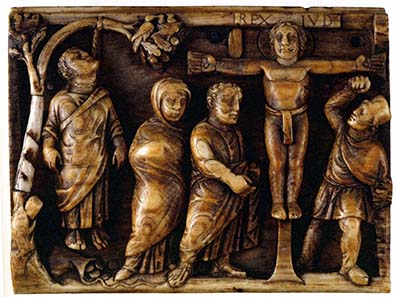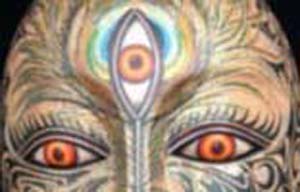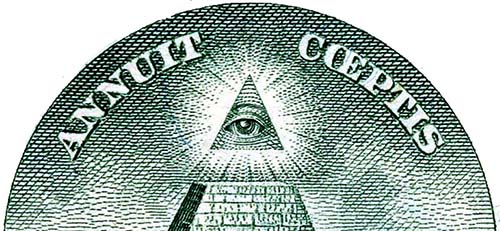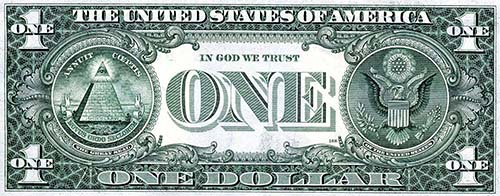July 7, 2011 – A rare silver coin of the Iceni, struck in Norfolk over 2000 years ago, was recently found by a metal detectorist in East Anglia.
Odin’s Eye silver unit of the Iceni, c.50-30 BC, ABC 1537 var. Only five recorded. Found in East Anglia, 2011. Source: Chris Rudd.
It shows a man’s head with one eye blinded (or closed) and with another eye – a third eye, an open eye – in his mouth. Who is he? What is he doing?
Wodan-head sceat, Denmark, c.AD 710-740, Series X, type 31. Found in Essex, 1997. Source: Chris Rudd.
I think he may be an Icenian counterpart of the Norse god Odin (German Woden, Anglo-Saxon Wotan) who sacrificed one eye in order to gain wisdom and the gift of prophecy. I think this amazing coin depicts the deity looking inwardly into the future – not with his physical eyes, but with his ‘inner eye’ or ‘third eye’ – and foretelling the future like a shaman or seer; in other words, he seems to be speaking with the all-seeing, all-knowing ‘eye of God’.
Odin lost an eye to find wisdom and the gift of prophecy. Picture: Georg von Rosen, 1886.
This is why I believe Odin (or whatever his Icenian name was) is portrayed here with an eye in his mouth – he is speaking with insight – and this is why I call the coin ‘Odin’s Eye’.
You may well wonder how a Scandinavian/Germanic god came to be on an ancient British coin, especially when that coin was minted hundreds of years before the Anglo-Saxons and Vikings invaded Britain.
Is this Skoll, the Norse wolf who swallowed the sun, or his half-brother Hati who slew the moon? Norfolk Wolf gold stater of the Iceni, c.55-45 BC, ABC 1396 var. Found in Norfolk, 23.9.2000. Source: Chris Rudd.
Dr Daphne Nash Briggs, author of Coinage in the Celtic World (Seaby 1987, Spink 2004) thinks that an ancient Germanic ancestry may have influenced the language, iconography and coin inscriptions of the Iceni and cites their famous Norfolk Wolf gold staters as evidence of this (Chris Rudd List 100, July 2008, pp. 8-9, Chris Rudd List 110, March 2010, pp. 2-4).
Some of the “spirit eyes” concealed on coins of the Corieltavi, North Sea neighbours of the Iceni. Source: Chris Rudd.
Strange, partially concealed ‘spirit eyes’ also occur on the coins of another eastern British tribe, the Corieltavi.
The “eye of God” on gold staters of the Suessiones and Treveri, c.100-50 BC, LT 8018, 8817, 8823. Both tribes belonged to the Belgae, most of whom had come from Germany, says Caesar (BG 2.4). Source: H.de La Tour, Atlas de monnaies gauloises, 1892.
Moreover, a number of iron age coins of northern and north-eastern Gaul – those parts of Gaul most obviously influenced by Germanic culture – give prominent display to the ‘eye of God’. One of them, a cast potin coin of the Suessiones, is nothing short of fantastic.
Odin with an eye in his mouth, Fenrir with Tyr’s arm in his jaws? Cast potin of the Suessiones, c.60-30 BC, LT 9194. Was Odin’s Eye copied from it? Both coins have a spoked sun-wheel. Source: H.de La Tour, Atlas de monnaies gauloises, 1892.
On one side we see a man with an eye in his mouth, like the Odin’s Eye coin but treated more realistically; on the other side we see Tyr (a son of Odin) with his left hand in the jaws of the wolf Fenrir who is standing on a sun-wheel. A superb specimen of this mythologically fascinating coin – as remarkable as it is rare – was recently sold for 2400 euros.
Another weird potin, also of the Suessiones, shows a big ‘eye of God’ with an eyebrow (or eyelashes) composed of a bristly-backed boar; this potin is occasionally found by metal detectorists in Britain where, not surprisingly, it is known as ‘Soissons Eye Boar’.
A big “eye of God” dominates both sides of this Belgic coin. The torc and globules were copied from Regenbogenschüsselchen (‘rainbow cups’) gold staters of southern Germany. Cast potin of the Suessiones, c.60-30 BC, LT 7905. Source: H.de La Tour, Atlas de monnaies gauloises, 1892.
The idea (or should I say eye-dea?) of the ‘eye of God’ or the ‘third eye’ is by no means confined to northern Europe; it occurs in many ancient and medieval belief systems all over the world, particularly in the middle east and far east.
This “eye of Horus” represents the oudjat, the restored “healthy and whole” eye. An Egyptian amulet against death, from the tomb of Tutankhamun, 1332-23 BC. Source: The Book of Symbols (2010) Copyright by ARAS/Taschen.
For example, the ‘eye of Horus’ of ancient Egypt, the ‘eye of Shiva’ of Hinduism, the ‘eye centre’ of Sikhism …
Rumi (1207-73), a Sufi mystic, says: “Close both eyes and see with the other eye” (Kulliyat-e Shams 2577) and “Man is eye and all the rest is worthless skin: the sight of that eye is seeing the Beloved” (Mathnawi I. 1406). This ‘eye of wisdom’ mandala is from a 15th century Islamic manuscript. Source: The Book of Symbols (2010) Copyright by ARAS/Taschen.
… and the ‘eye of wisdom’ or ‘eye of dharma’ of Buddhism – an organ of inner vision, expressed in Islam by ‘breaking the barrier of the two eyes’. Eskimos call their shamans and seers ‘the people with eyes’. Both Plato and Clement of Alexandria says that the ‘eye of the soul’ is not only single but immobile. Plotinus, St Paul, St Augustine, St John Climacus, Philotheus of Sinai, Elias the Ecdosite and St Gregory of Nazianus all talk about the ‘eye of the heart’ or the ‘eye of the spirit’, as do most of the Sufi mystics of Islam.
Christ was hanged on a cross, Odin on a tree. Both resurrected, both had the insight of a ‘single eye’ and both had followers in East Anglia, where Odin’s Eye had been minted 700 years earlier. Relief from Roman ivory casket, c. AD 425.
And Jesus Christ is apparently referring to a ‘spiritual eye’ or ‘inner eye’ when he says: “The light of the body is the eye: if therefore thine eye be single, thy whole body shall be full of light” (Matthew 6:22). Presumably the light of enlightenment rather than daylight or the light of an oil-lamp?
In 1939 an American surgeon, Dr Julian Johnson, said that the ‘third eye’ is “situated back of the eyes on a level with the lower part of the eyeballs, but exactly in the centre of the brain cavity, at a point in the subtle body, corresponding to the position of the pineal gland. That is the seat of the mind and soul.” An opinion not shared by many other doctors. Face mask, Google.
Images of the ‘inner eye’ and ‘eye of God’ are still around today, not just on new age websites and in Californian meditation classes, but also in the hard-nosed world of money.
A masonic ‘eye of God’ watches over this US banknote which says “In God we trust” and “He has favoured our undertakings.” Oh yeah? Maybe if US bankers and hedge-fund managers had had Odin’s eye they would have seen the future more clearly. Source: Chris Rudd.
Look at the back of a US one dollar bill and you’ll soon see what I mean. The Odin’s Eye silver coin will be sold by auction by Elizabeth Cottam of Chris Rudd on Monday, 12 September.
For more information and articles by Chris Rudd visit its website.


